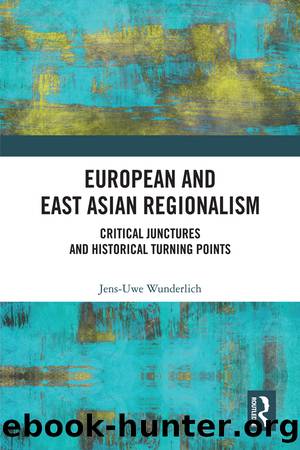European and East Asian Regionalism: Critical Junctures and Historical Turning Points by Jens Uwe Wunderlich

Author:Jens Uwe Wunderlich [Wunderlich, Jens Uwe]
Language: eng
Format: epub
ISBN: 9781000197662
Goodreads: 53371385
Publisher: Routledge
Published: 2020-10-15T00:00:00+00:00
Nixonâs rapid movements on Vietnamisation and his visit to Beijing in February 1972 came as a surprise to many. The gradual decline of British power in the region, particularly in Southeast Asia, is also of importance here. In 1964, Britain maintained a major military presence in Malaysia and Singapore. Yet only four years later, in 1968, the Wilson government announced that it would withdraw from its major Southeast Asian bases by the end of 1971.8 This British retreat coincided with an increasing interest and involvement of the Soviet Union in the area, particularly in South Asia and the Indian Ocean (Millar, 1970). It was feared that the withdrawal of American and, to a lesser extent, British forces from Southeast Asia would generate a power vacuum which would invite Soviet and Chinese expansionary activities. Chinaâs quest for renewed great power status has its origins in the 1950s. By fighting the US to a standstill in the Korean War, tacking on the Soviet Union in the 1968 border war and helping the Vietnamese to defeat the French and the Americans, China had emerged as a regional power to be reckoned with. Americaâs East Asian partners, therefore, were forced to reassess their relations with the US, China and each other. Changing external circumstances served as a catalyst for closer regional cooperation in Southeast Asia.
Institutional supply, however, was determined by intra-regional factors. Southeast Asiaâs non-Communist states elected to enhance ASEANâs functionality. Each ASEAN member had its own position regarding the changing international balance of power and its regional implications. The Philippines and Thailand, for example, were committed US allies and members of SEATO. The Philippines were especially dependent on the US in economic and military terms, and Nixonâs Vietnamisation policy raised questions about the credibility of US defence commitments.9 Thailand had emerged as a frontline state in the fight to ward off Communist (and Chinese) expansionism, becoming an important location for US bases and military installations. Furthermore, Thailand had despatched troops to support the beleaguered Saigon regime, fighting alongside American forces. Bangkok had a special interest in South Vietnamâs survival â being a frontline state, a victory of the North over the South would herald the spectre of a hostile regime right on Thailandâs border, which would potentially offer support to various local insurgent groups active within Thai territory. This also explains Bangkokâs hard-line approach to Beijing, following the US containment approach, while being much more flexible in its relations with the distant USSR.10
As just mentioned, the Nixon doctrine placed a strong emphasis on supporting multilateral cooperation among Asian countries to maintain the balance of power in East Asia (Buss, 1977, p. 57). The emphasis on SEATO initially reassured the Thai government that US support for Thailand would remain firm, even in the event of a withdrawal of US troops from the Southeast Asian mainland. Sino-US rapprochement, however, renewed doubts about US commitment to its alliance partners. Nixonâs announcement to travel to Beijing came as a shock to the Thai leadership which had not been informed in advance about the fundamental shift in US policy towards the PRC.
Download
This site does not store any files on its server. We only index and link to content provided by other sites. Please contact the content providers to delete copyright contents if any and email us, we'll remove relevant links or contents immediately.
Deep learning with TensorFlow and Keras by Derrick mwiti(865)
Understanding PDA Autism in Kids: A Guide for Parents and Teachers to Support Neurodiverse Learners by Jehu Len(717)
The Victorian Era: A Captivating Guide to the Life of Queen Victoria and an Era in the History of the United Kingdom Known for Its Hierarchy-Based Social Order by Captivating History(499)
100 Ideas for Secondary Teachers: Engaging Parents by Janet Goodall & Kathryn Weston(479)
Intersectionality in Educational Research by Dannielle Joy Davis; James L. Olive; Rachelle J. Brunn-Bevel; Susan R. Jones(477)
How to be assertive in any situation by Hadfield Sue & Hasson Gill(461)
Writing Solid Code: Development Philosophies for Writing Bug-Free Programs by Steve Maguire(458)
Brain Teasers to Build Critical Thinking Skills: Brain Exercises for Tech, Banking, Case Interview Prep, and to Keep Your Mind Sharp by Kris Safarova(453)
Brain Teasers to Build Critical Thinking Skills by Safarova Kris(449)
Python 101 - Fundamentals by Sam(411)
Critical Curriculum Leadership : A Framework for Progressive Education by Rose M. Ylimaki(409)
The Art of Emotional Validation: Improve Your Communication Skills and Transform Your Relationships by Validating Emotions and Feelings by Emily Wright(378)
The Knights Templar: An Enthralling History of the Rise and Fall of the Most Influential Catholic Military Order by Wellman Billy(369)
A Beginner's Guide to SSD Firmware by Unknown(365)
The Future Knowledge Compendium by Ellyard Peter;(364)
What Every Teacher Should Know about Learning, Memory, and the Brain by Tileston Donna E. Walker;(362)
NumPy : From Basic to Advance by bisht Karan Singh(349)
Making Connections in and Through Arts-Based Educational Research by Hala Mreiwed Mindy R. Carter Sara Hashem Candace H. Blake-Amarante(342)
Alma Maters (5th edition) by Unknown(336)
